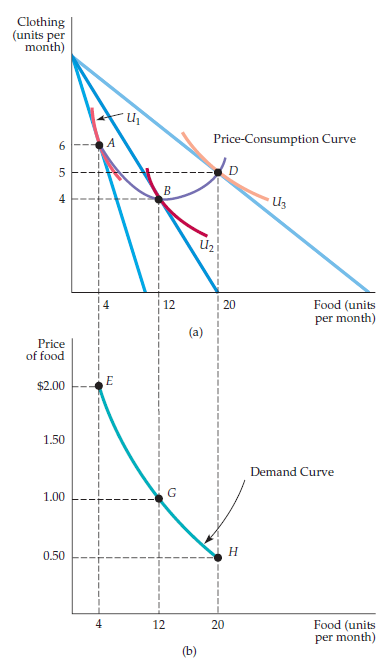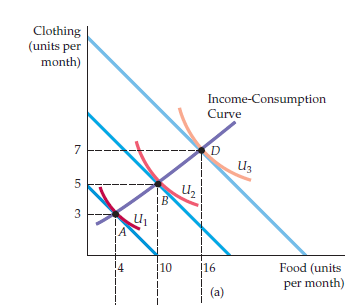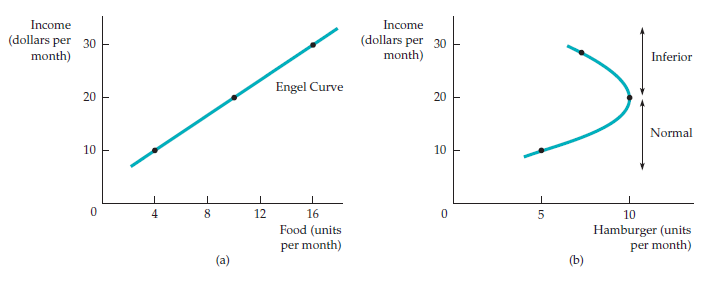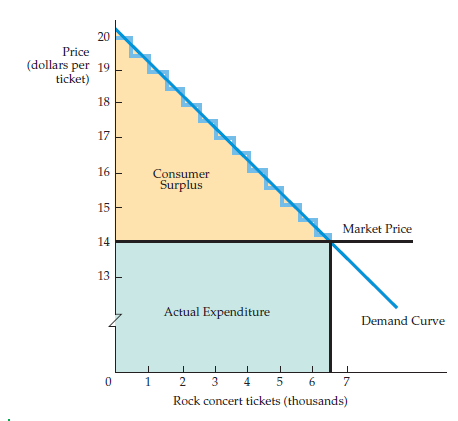第四章 个人需求和市场需求
一种商品的需求是如何取决于这种商品的价格及其他商品的价格和收入的。
个人需求
价格-消费曲线 (price consumption curve)勾画了与一种商品每一种可能的价格相对应的效用最大化的商品组合。
个人需求曲线(individual demand curve)将单一消费者会购买的商品数量和该商品的价格联系起来。

- 当沿着需求曲线移动时,可获得的效用水平会发生变化。
- 在曲线的每一个点上,消费者通过满足边际替代率(MRS)等于价格之比来使效用最大化。
收入-消费曲线(income consumption curve)勾画出与每一收入水平对应的效用最大化时的商品组合。

正常商品(normal good)的收入消费曲线的斜率为正数;劣质商品(inferior good)的斜率有时为负数,当收入增加时,有时消费反而下降。
恩格尔曲线(Engel curves)将一种商品的消费量与收入联系起来。

通过观察价格消费曲线的走势可以判断两种商品是替代品、互补品还是独立品。
效用最大化
消费者行为的理论的基础是假设消费者在预算约束下最大化其效用。该问题可以写成:
该问题可以使用拉格朗日乘数法解决。
收入效应和替代效应
一种商品价格的下跌有两种效应:
- 替代效应(substitution effect):消费者往往会更多地购买变得便宜的商品,而减少购买哪些变得相对较贵的商品。
- 收入效应(income effect):因为其中的一种商品变得便宜了,消费者的实际购买力得到了提高。
替代效应是在效应水平保持不变的情况下因为一种商品的价格变化导致的消费变化,表现为沿着无差异曲线的一次移动。
收入效应是在相对价格保持不变的情况下,因购买力的增加而带来的消费变化。
总效应=替代效应+收入效应
替代效应的方向总是一致的,商品价格的下跌会导致其消费量的增加。收入效应可以使需求向两个方向移动,取决于该商品是正常商品还是劣质商品。
收入效应可能足够大,以致于价格下跌时其需求也变小,这种商品称作吉芬商品(Giffen good)。
注:实际上上述的替代效应指希克斯替代效应。替代效应是指商品相对价格变化后,而令消费者实际收入不变情况下所引起的商品需求量的变化。希克斯替代效应与斯勒茨基替代效应的差别,在于他们对什么是消费者实际收入不变所下的不同定义。在希克斯替代效应中,实际收入不变是指使消费者在价格变化前后保持在同一条无差异曲线上;而在斯勒茨基替代效应中,实际收入不变是指消费者在价格变化后能够买到价格变动以前的商品组合。(详情参见这里))
$P_X$的1单位变化所造成的$X$的总变化为:
其中第一项即为替代效应,第二部分即为收入效应。该方程称作斯拉茨基方程(Slutsky equation)。
市场需求
市场需求曲线为每个消费者需求的水平加总(horizontal summation).
- 当更多的消费者进入市场时,市场需求曲线将会右移。
- 影响大多数消费者需求的因素也会影响市场需求。
回忆:需求的价格弹性$E_P=\frac{\Delta Q/Q}{\Delta P/P}=\left( \frac{P}{Q}\right)\left(\frac{\Delta Q}{\Delta P}\right)$
- 当需求缺乏弹性($\left| E_P \right|<1$),价格上涨会使该商品上的总支出增加。
- 当需求富有弹性($\left| E_P \right|>1$),价格上涨会使该商品上的总支出下降。
消费者剩余
消费者剩余(consumer surplus)度量了消费者在市场上购买商品后生活在总体上得到改善的程度。个别消费者剩余就是消费者为某一商品愿意支付的最大数额与消费者实际支付的数额之间的差额。

消费者剩余度量了消费者在一个市场中购买商品所获得的总收益。
网络外部性
网络外部性(network externality):一个人对一种商品的需求受其他人已经购买的该商品数量的影响。该影响可正可负。
攀比效应(bandwagon effect)是正网络外部性。该效应使需求相对更富有弹性。
虚荣效应(snob effect)是负网络外部性。该效应使需求变得缺乏弹性。
需求的经验估计
需求关系通常可以以以下形式进行估计:
对数形式中b即为需求的价格弹性,c即为需求的收入弹性。
考虑另一种商品时,可以使用以下形式:
获取有关需求的信息可以通过面谈或者直接推销实验等方式。
Exercise
Explain the difference between each of the following terms:
a price consumption curve and a demand curve
The price consumption curve (PCC) shows the quantities of two goods a consumer will purchase as the price of one of the goods changes, while a demand curve shows the quantity of one good a consumer will purchase as the price of that good changes. The graph of the PCC plots the quantity of one good on the horizontal axis and the quantity of the other good on the vertical axis. The demand curve plots the quantity of the good on the horizontal axis and its price on the vertical axis.an individual demand curve and a market demand curve
An individual demand curve plots the quantity demanded by one person at various prices. A market demand curve is the horizontal sum of all the individual demand curves. It plots the total quantity demanded by all consumers at various prices.- an Engel curve and a demand curve
An Engel curve shows the quantity of one good that will be purchased by a consumer at different income levels. The quantity of the good is plotted on the horizontal axis and the consumer’s income is on the vertical axis. A demand curve is like an Engel curve except that it shows the quantity purchased at different prices instead of different income levels. - an income effect and a substitution effect
Both the substitution effect and income effect occur because of a change in the price of a good. The substitution effect is the change in the quantity demanded of the good due to the price change, holding the consumer’s utility constant. The income effect is the change in the quantity demanded of the good due to the change in purchasing power brought about by the change in the good’s price.
Q:Judy has decided to allocate exactly $500 to college textbooks every year, even though she knows that the prices are likely to increase by 5 to 10% per year and that she will be getting a substantial monetary gift from her grandparents next year. What is Judy’s price elasticity of demand for textbooks? Income elasticity?
A:Judy will spend the same amount ($500) on textbooks even when prices increase. We know that total revenue (i.e., total spending on a good) remains constant when price changes only if demand is unit elastic. Therefore Judy’s price elasticity of demand for textbooks is −1. Her income elasticity must be zero because she does not plan to purchase more books even though she expects a large monetary gift (i.e., an increase in income).